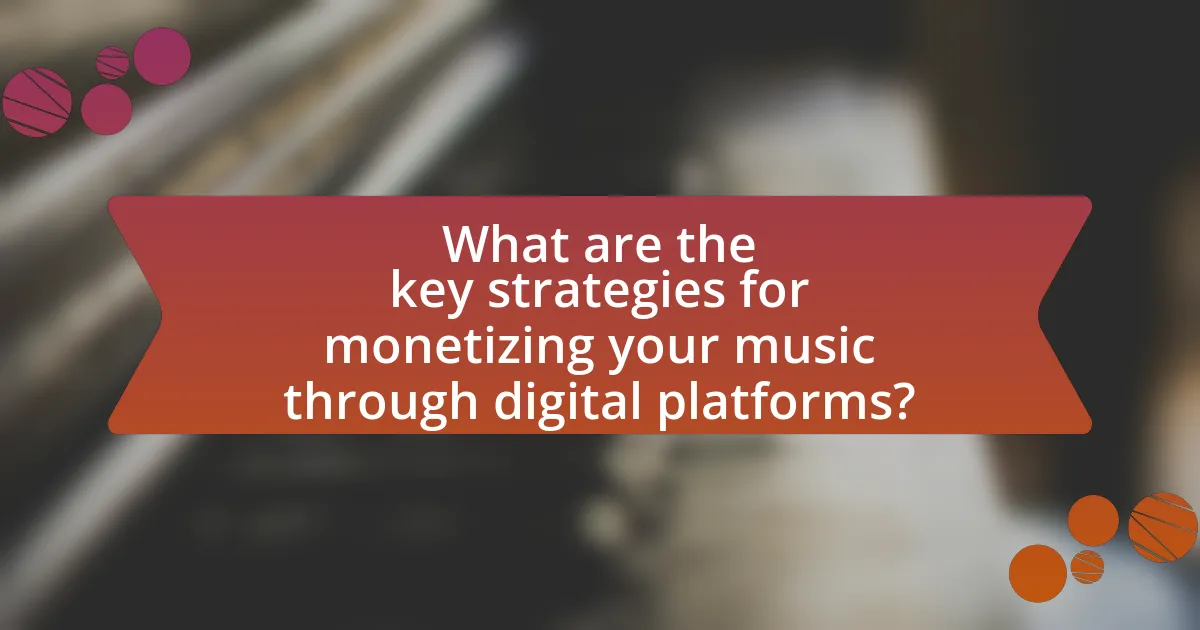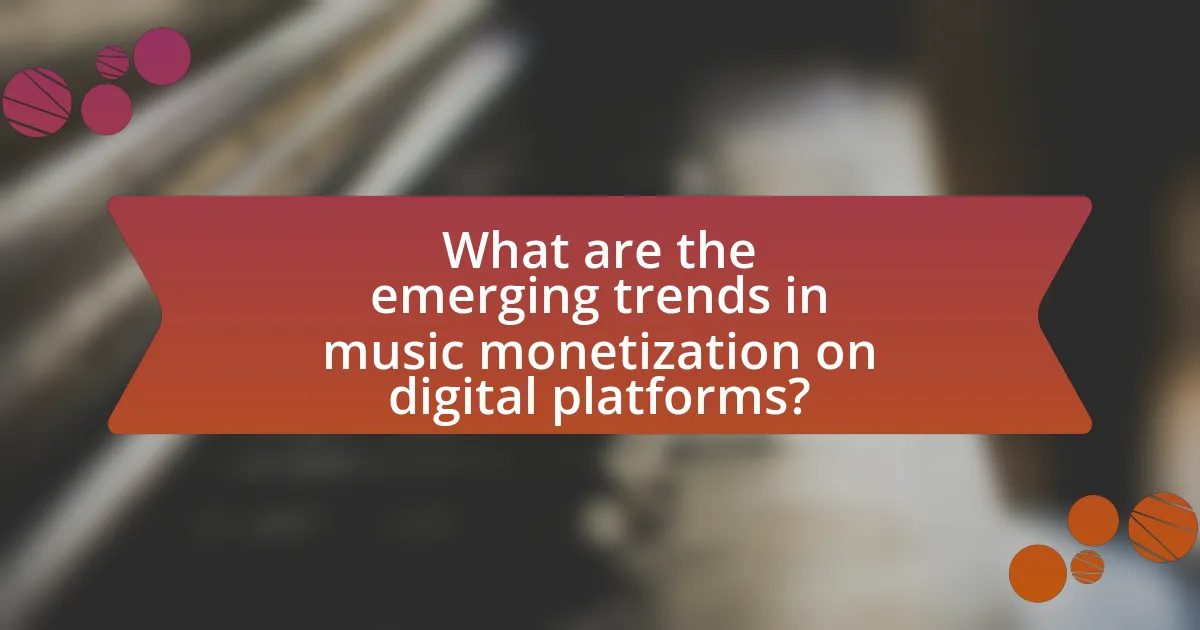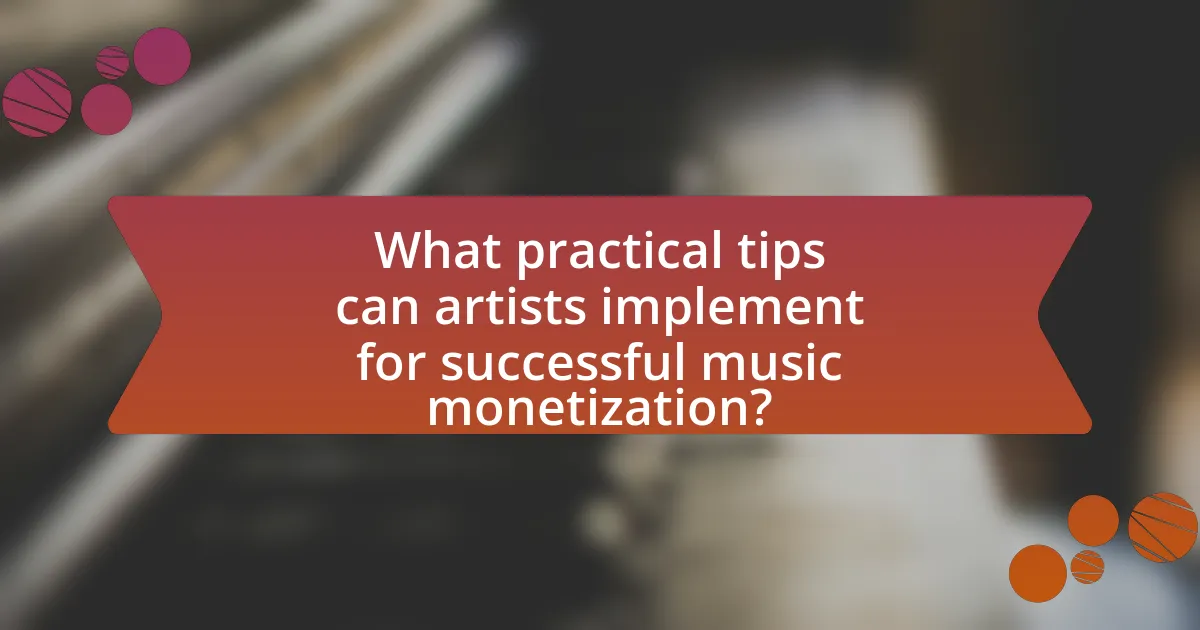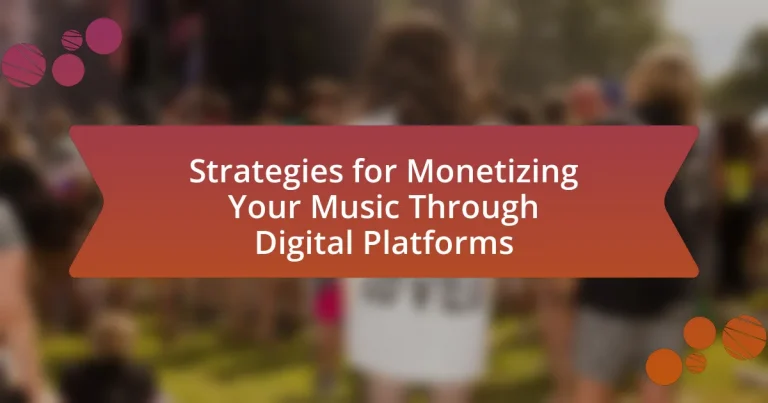The article focuses on strategies for monetizing music through digital platforms, highlighting key revenue streams such as streaming, digital downloads, merchandise sales, licensing, and crowdfunding. It details how streaming services like Spotify and Apple Music operate, the importance of digital downloads, and the role of social media in enhancing visibility and engagement. Additionally, the article explores emerging trends like NFTs and live streaming concerts, providing practical tips for artists to optimize their distribution and marketing efforts while avoiding common pitfalls. Overall, it serves as a comprehensive guide for artists seeking to maximize their income in the digital music landscape.

What are the key strategies for monetizing your music through digital platforms?
The key strategies for monetizing music through digital platforms include streaming revenue, digital downloads, merchandise sales, licensing, and crowdfunding. Streaming platforms like Spotify and Apple Music pay artists based on the number of streams, with Spotify reportedly paying between $0.003 and $0.005 per stream. Digital downloads on platforms such as iTunes allow artists to sell their music directly to consumers, generating revenue per sale. Merchandise sales through platforms like Bandcamp or Shopify enable artists to sell branded products, which can significantly boost income. Licensing music for use in films, commercials, or video games can provide substantial payouts, with some licenses fetching thousands of dollars. Crowdfunding through platforms like Patreon or Kickstarter allows fans to support artists directly, often in exchange for exclusive content or experiences. These strategies collectively enhance an artist’s revenue potential in the digital landscape.
How can streaming services be utilized for music monetization?
Streaming services can be utilized for music monetization by allowing artists to earn revenue through streaming royalties based on the number of plays their songs receive. These platforms, such as Spotify and Apple Music, distribute a portion of their subscription and advertising revenue to rights holders, which includes songwriters, producers, and performers. According to the Recording Industry Association of America (RIAA), streaming accounted for 83% of the U.S. music industry’s revenue in 2020, highlighting the significant financial impact of these services. Additionally, artists can leverage playlists and algorithmic recommendations on these platforms to increase their visibility and listener base, further enhancing their earning potential.
What are the most popular streaming platforms for artists?
The most popular streaming platforms for artists are Spotify, Apple Music, and YouTube Music. Spotify leads the market with over 500 million users, providing artists with extensive reach and promotional tools. Apple Music, with around 88 million subscribers, offers a strong ecosystem for artists, especially those already in the Apple ecosystem. YouTube Music, leveraging the vast user base of YouTube, allows artists to monetize through ad revenue and subscriptions, making it a significant platform for music distribution. These platforms not only facilitate music streaming but also provide analytics and promotional opportunities that are crucial for artists looking to monetize their work effectively.
How do royalties from streaming services work?
Royalties from streaming services are payments made to artists, songwriters, and rights holders based on the number of times their music is streamed. Streaming platforms like Spotify, Apple Music, and others calculate royalties using a pro-rata system, where a portion of the total subscription or advertising revenue is distributed to rights holders based on their share of total streams. For example, if an artist’s song accounts for 1% of all streams in a given payout period, they receive 1% of the total royalties allocated for that period. According to the Music Industry Report, in 2021, Spotify paid approximately $0.003 to $0.005 per stream, illustrating the financial model behind streaming royalties.
What role do digital downloads play in music monetization?
Digital downloads are a significant revenue stream in music monetization, contributing to artists’ income through direct sales. In 2020, digital downloads accounted for approximately 10% of total music revenue in the United States, highlighting their importance despite the rise of streaming services. This revenue model allows artists to sell individual tracks or entire albums directly to consumers, providing a more immediate financial return compared to other formats. Additionally, platforms like iTunes and Bandcamp facilitate these transactions, enabling artists to reach a global audience and retain a larger share of the profits compared to traditional physical sales.
How can artists effectively sell their music online?
Artists can effectively sell their music online by utilizing digital distribution platforms, social media marketing, and direct-to-fan sales strategies. Digital distribution platforms like Spotify, Apple Music, and Bandcamp allow artists to reach a global audience and earn revenue through streaming and downloads. Social media marketing enables artists to engage with fans, promote new releases, and drive traffic to their sales channels. Direct-to-fan sales strategies, such as offering exclusive content or merchandise through platforms like Patreon or their own websites, can enhance revenue and foster a loyal fanbase. According to a 2021 report by the International Federation of the Phonographic Industry, global recorded music revenues grew by 7.4%, highlighting the effectiveness of these online sales strategies.
What platforms are best for digital music sales?
The best platforms for digital music sales are Spotify, Apple Music, Amazon Music, and Bandcamp. These platforms dominate the digital music market, with Spotify boasting over 500 million users and Apple Music having more than 88 million subscribers as of 2023. Amazon Music has rapidly grown, reaching over 100 million subscribers, while Bandcamp is favored by independent artists for its artist-friendly revenue model, allowing musicians to retain a larger share of sales. These statistics demonstrate their effectiveness in facilitating music sales and reaching a broad audience.
How can social media enhance music monetization efforts?
Social media enhances music monetization efforts by providing artists with direct access to their audience, facilitating engagement, and enabling targeted marketing. Platforms like Instagram, TikTok, and Facebook allow musicians to share content, promote merchandise, and drive traffic to streaming services. For instance, TikTok’s viral trends can lead to significant increases in song streams, as evidenced by the fact that songs featured in viral challenges often see a 300% increase in streams shortly after the trend begins. Additionally, social media enables artists to build a loyal fanbase, which can translate into higher sales of concert tickets and merchandise, further boosting revenue.
What strategies can artists use to promote their music on social media?
Artists can promote their music on social media by utilizing targeted advertising, engaging content, and collaborations with influencers. Targeted advertising allows artists to reach specific demographics, increasing the likelihood of attracting listeners who are interested in their genre. Engaging content, such as behind-the-scenes videos, live performances, and interactive posts, fosters a connection with fans and encourages sharing, which can amplify reach. Collaborating with influencers can introduce the artist to new audiences, as influencers often have established trust with their followers. According to a study by the Pew Research Center, 72% of adults use social media, making it a vital platform for music promotion.
How can social media engagement lead to increased sales?
Social media engagement can lead to increased sales by fostering direct connections between artists and their audience, which enhances brand loyalty and drives purchasing behavior. When musicians actively interact with fans through comments, shares, and live sessions, they create a sense of community and belonging, encouraging fans to support their work financially. According to a study by Nielsen, 92% of consumers trust recommendations from individuals over brands, highlighting the effectiveness of personal engagement in influencing buying decisions. Additionally, platforms like Instagram and Facebook allow for targeted advertising, enabling artists to reach specific demographics that are more likely to convert into paying customers. This strategic use of social media not only amplifies visibility but also cultivates a loyal fan base that is more inclined to purchase music, merchandise, and concert tickets.

What are the emerging trends in music monetization on digital platforms?
Emerging trends in music monetization on digital platforms include the rise of subscription-based models, direct-to-fan sales, and the integration of blockchain technology. Subscription services like Spotify and Apple Music have shifted the revenue model from per-track purchases to monthly fees, allowing artists to earn through streaming royalties. Direct-to-fan sales, facilitated by platforms such as Bandcamp, enable musicians to sell merchandise and music directly to their audience, increasing profit margins. Additionally, blockchain technology is being explored for its potential to provide transparent royalty distribution and smart contracts, which can ensure artists receive fair compensation for their work. These trends reflect a significant shift in how artists can generate income in the digital landscape.
How is the rise of NFTs impacting music monetization?
The rise of NFTs is significantly transforming music monetization by enabling artists to sell unique digital assets directly to fans, thereby bypassing traditional distribution channels. This direct-to-fan model allows musicians to retain a larger share of revenue, as they can set their own prices and terms for their work. For instance, artists like Grimes and Kings of Leon have successfully sold NFT albums, generating millions in revenue, which illustrates the potential for substantial earnings through this medium. Additionally, NFTs create new revenue streams through royalties on secondary sales, allowing artists to benefit from the appreciation of their work over time. This shift not only empowers musicians financially but also fosters deeper connections with their audience, as fans can own a piece of the artist’s work.
What are the benefits of using NFTs for music artists?
The benefits of using NFTs for music artists include enhanced revenue streams, increased fan engagement, and ownership control. NFTs allow artists to sell unique digital assets, such as exclusive tracks or concert tickets, directly to fans, bypassing traditional intermediaries and retaining a larger share of the profits. For instance, in 2021, the musician Grimes sold NFT artwork for nearly $6 million, showcasing the potential for significant earnings. Additionally, NFTs foster deeper connections with fans by offering them exclusive content and experiences, which can lead to increased loyalty and support. Furthermore, artists maintain ownership of their work, enabling them to earn royalties on secondary sales, thus creating ongoing revenue opportunities.
How can artists create and sell their own NFTs?
Artists can create and sell their own NFTs by following a series of steps that involve selecting a blockchain, creating digital art or music, minting the NFT, and listing it on a marketplace. First, artists choose a blockchain that supports NFTs, such as Ethereum or Binance Smart Chain. Next, they create their digital asset, which can be artwork, music, or other forms of media. After that, artists mint the NFT using a platform like OpenSea or Rarible, which involves uploading their digital file and paying a gas fee for the transaction. Finally, they list the NFT for sale on the chosen marketplace, setting a price or opting for an auction format. This process allows artists to monetize their work directly, leveraging the growing interest in digital collectibles and ownership.
What is the significance of live streaming concerts for revenue generation?
Live streaming concerts significantly enhance revenue generation for artists and music industry stakeholders by expanding audience reach and creating new monetization avenues. Unlike traditional concerts, live streaming allows performers to engage with global audiences, thus increasing ticket sales and merchandise opportunities. For instance, in 2020, the virtual concert industry saw a surge, with platforms like Veeps reporting a 300% increase in ticket sales compared to previous years. Additionally, live streaming can incorporate sponsorships and advertising, further diversifying income streams. This shift not only provides immediate financial benefits but also fosters long-term fan engagement, which is crucial for sustained revenue growth in the digital music landscape.
How can artists effectively monetize live streaming events?
Artists can effectively monetize live streaming events by implementing multiple revenue streams such as ticket sales, merchandise sales, and sponsorships. For instance, platforms like Twitch and YouTube allow artists to charge for access to exclusive live performances, creating a direct income source. Additionally, artists can sell branded merchandise during the stream, capitalizing on real-time engagement with their audience. Sponsorships from brands looking to reach the artist’s fan base can further enhance revenue, as companies often pay for product placements or promotional mentions during the event. According to a report by Statista, the global live streaming market is projected to reach $184.3 billion by 2027, indicating significant potential for artists to tap into this growing trend for monetization.
What platforms are best for live streaming music performances?
The best platforms for live streaming music performances are Twitch, YouTube Live, Facebook Live, and Instagram Live. Twitch is popular for its interactive features and large music community, allowing artists to engage with fans in real-time. YouTube Live offers extensive reach and monetization options through ads and Super Chats, making it a strong choice for artists. Facebook Live enables easy sharing and audience interaction, while Instagram Live provides a user-friendly interface for quick performances and direct fan engagement. These platforms collectively support artists in monetizing their music through donations, subscriptions, and merchandise sales.
How can merchandise sales complement music monetization strategies?
Merchandise sales can significantly enhance music monetization strategies by providing additional revenue streams and fostering deeper fan engagement. By selling branded products such as clothing, accessories, and physical music formats, artists can capitalize on their brand identity and increase overall earnings. For instance, a study by the Music Industry Research Association found that artists who actively promote merchandise alongside their music saw a 30% increase in total revenue compared to those who did not. This synergy not only boosts financial returns but also strengthens the connection between artists and their audience, leading to increased loyalty and support.
What types of merchandise are most popular among music fans?
Apparel, such as t-shirts and hoodies, is the most popular type of merchandise among music fans. This popularity is evidenced by the fact that merchandise sales can account for a significant portion of an artist’s revenue, with some reports indicating that merchandise can generate up to 30% of total income for musicians during tours. Additionally, items like vinyl records, posters, and accessories also rank highly among fan purchases, reflecting a strong demand for tangible connections to their favorite artists.
How can artists integrate merchandise sales with their music platforms?
Artists can integrate merchandise sales with their music platforms by utilizing built-in e-commerce features on streaming services and social media platforms. For instance, platforms like Bandcamp allow artists to sell merchandise directly alongside their music, enabling fans to purchase items while listening to tracks. Additionally, artists can leverage social media tools, such as Instagram Shopping, to showcase merchandise linked to their music, driving traffic to their online stores. This integration not only enhances the fan experience but also increases revenue streams, as evidenced by a 2021 report from the Music Industry Association, which found that artists who actively promote merchandise alongside their music saw a 30% increase in overall sales.

What practical tips can artists implement for successful music monetization?
Artists can implement several practical tips for successful music monetization, including leveraging streaming platforms, engaging in social media marketing, and diversifying revenue streams. Utilizing platforms like Spotify and Apple Music allows artists to earn royalties based on the number of streams, with Spotify alone paying out approximately $0.003 to $0.005 per stream. Engaging with fans through social media can enhance visibility and drive traffic to music sales, as artists with active social media presence often see higher engagement and sales. Additionally, diversifying revenue streams by selling merchandise, offering exclusive content through platforms like Patreon, and performing live shows can significantly increase overall income. According to a 2021 report by the Music Industry Association, artists who diversify their income sources can earn up to 50% more than those relying solely on music sales.
How can artists build a loyal fanbase to enhance monetization?
Artists can build a loyal fanbase to enhance monetization by engaging directly with their audience through social media, offering exclusive content, and creating a sense of community. Direct engagement on platforms like Instagram and TikTok allows artists to connect personally with fans, fostering loyalty. Exclusive content, such as behind-the-scenes footage or early access to new releases, incentivizes fans to support the artist financially. Additionally, creating a community through fan clubs or interactive live streams encourages deeper connections, leading to increased merchandise sales and concert attendance. Research indicates that artists who actively engage with their fans can see a 30% increase in revenue from merchandise and ticket sales, demonstrating the effectiveness of these strategies.
What strategies can be used to engage and retain fans?
To engage and retain fans, artists can utilize strategies such as personalized communication, exclusive content offerings, and interactive experiences. Personalized communication, such as targeted emails or social media messages, fosters a sense of connection, making fans feel valued. Exclusive content offerings, like behind-the-scenes videos or early access to new music, incentivize fans to stay engaged. Interactive experiences, including live Q&A sessions or virtual meet-and-greets, enhance fan involvement and loyalty. Research indicates that 70% of fans are more likely to remain loyal to artists who provide personalized experiences, demonstrating the effectiveness of these strategies in building lasting relationships.
How does fan engagement translate into revenue?
Fan engagement translates into revenue primarily through increased sales of merchandise, concert tickets, and digital content. Engaged fans are more likely to purchase products and services offered by artists, as they feel a personal connection and loyalty. For instance, a study by the Music Industry Research Association found that artists with higher fan engagement saw a 30% increase in merchandise sales compared to those with lower engagement levels. Additionally, platforms like Patreon and Bandcamp enable artists to monetize their fanbase directly, with engaged fans often subscribing for exclusive content or experiences. This direct relationship between fan engagement and revenue generation is crucial for artists seeking to maximize their income through digital platforms.
What are the best practices for optimizing music distribution on digital platforms?
The best practices for optimizing music distribution on digital platforms include selecting the right distribution service, ensuring high-quality audio files, and utilizing metadata effectively. Choosing a reputable distribution service, such as DistroKid or TuneCore, allows artists to reach multiple platforms like Spotify and Apple Music efficiently. High-quality audio files, typically in WAV format, enhance listener experience and can lead to better engagement. Additionally, effective use of metadata, including accurate song titles, artist names, and genre tags, improves discoverability and searchability on these platforms. According to a study by the International Federation of the Phonographic Industry, proper metadata can significantly increase streaming numbers, demonstrating the importance of these practices in maximizing reach and revenue.
How can artists ensure their music reaches the right audience?
Artists can ensure their music reaches the right audience by utilizing targeted marketing strategies and leveraging data analytics. By analyzing listener demographics and preferences through platforms like Spotify for Artists and Apple Music for Artists, musicians can identify their core audience. Additionally, employing social media advertising, such as Facebook Ads or Instagram promotions, allows artists to reach specific groups based on interests, location, and behavior. According to a 2021 report by MIDiA Research, targeted digital marketing can increase engagement rates by up to 30%, demonstrating the effectiveness of these strategies in connecting with the right listeners.
What tools can assist in tracking music performance and sales?
Tools that assist in tracking music performance and sales include platforms like Spotify for Artists, Apple Music for Artists, and SoundCloud Analytics. These tools provide artists with detailed insights into streaming numbers, listener demographics, and sales data. For instance, Spotify for Artists allows musicians to see how many times their tracks have been streamed, the locations of their listeners, and how their music is performing over time. Similarly, Apple Music for Artists offers analytics on song plays, purchases, and trends, enabling artists to make informed decisions about their marketing strategies. SoundCloud Analytics provides data on track plays, likes, and comments, helping artists understand audience engagement. These tools are essential for artists to effectively monetize their music through digital platforms by providing actionable insights into their performance and sales metrics.
What common pitfalls should artists avoid in digital music monetization?
Artists should avoid underestimating the importance of marketing in digital music monetization. Many artists focus solely on creating music without promoting it effectively, leading to low visibility and sales. According to a 2021 survey by the Music Industry Research Association, 70% of independent artists reported that lack of marketing knowledge hindered their revenue potential. Additionally, artists often neglect to understand the terms of streaming platforms, which can result in unfavorable revenue splits. For instance, Spotify pays artists an average of $0.003 to $0.005 per stream, making it crucial for artists to maximize their audience reach to generate significant income. Lastly, failing to diversify income streams, such as merchandise sales or live performances, can limit financial growth; a report from the Future of Music Coalition indicates that artists who diversify their revenue sources earn 30% more than those who rely solely on streaming.
How can artists protect their music from piracy and unauthorized use?
Artists can protect their music from piracy and unauthorized use by registering their works with copyright offices and utilizing digital rights management (DRM) technologies. Copyright registration provides legal protection, allowing artists to take legal action against infringers, while DRM technologies help control access and distribution of digital music. According to the U.S. Copyright Office, registering a copyright not only establishes ownership but also enables artists to seek statutory damages and attorney fees in case of infringement. Additionally, platforms like SoundCloud and Bandcamp offer built-in tools to manage rights and monetize music, further safeguarding artists’ interests.
What are the consequences of neglecting digital marketing strategies?
Neglecting digital marketing strategies can lead to significant consequences, including reduced visibility and engagement with target audiences. Without effective digital marketing, artists may struggle to reach potential listeners, resulting in lower streaming numbers and diminished sales. According to a study by the International Federation of the Phonographic Industry, 70% of music consumption occurs through digital platforms, highlighting the necessity of a strong online presence. Additionally, failure to engage in digital marketing can lead to missed opportunities for collaboration and partnerships, which are crucial for growth in the competitive music industry.




